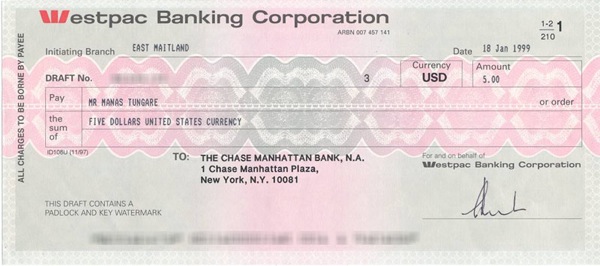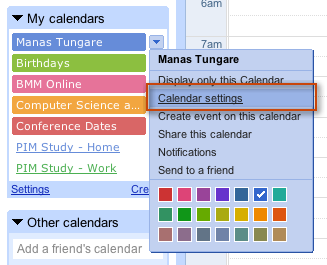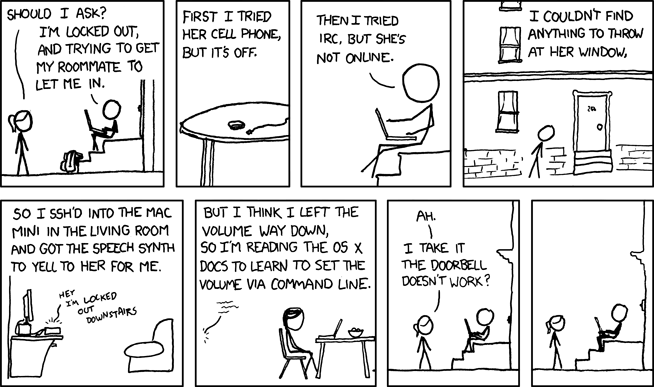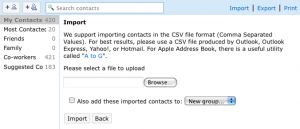10th Anniversary of my First Shareware Paycheck
10 years ago, on this day, I received the first payment for a tiny shareware program I wrote. It was a one-trick-pony, a birthday reminder program.
Folks around me will tell you I'm bad at remembering things, and always choose to write everything down. So I wrote a program to keep track of friends and birthdays, and popup a reminder on the right day, perhaps a few days earlier if I needed to buy a gift first. As a teen writing and distributing my first-ever commercial piece of software, I had named it eponymously as ManasTech Birthdays. I wrote it, released it, and sold a few copies (nothing astronomical, but yeah, it was fun to see the checks coming in.)

As I look back nostalgically, several thoughts cross my mind today. The more things have changed, the more they have remained the same. I loved writing software then, I love writing software now. I used to sneak out of classes and stay up late nights to code up the latest idea that crossed my mind. Today, I procrastinate on my research and take time off to write little scripts and tiny widgets, that -- before you know it -- have hundreds of users and need regular maintenance.
Then, the norm was to release products as shareware, without the hassles of finding a publisher or having to stock shelves with packaging. All you needed was an Internet connection and a program that solved a need. Today, the norm is to free your software, and release it into the wild. The Free Software Movement has been gaining ground ever since.
The most interesting aspect is perhaps the domain in which I've been working. The Birthday Manager helped store your personal information -- contacts and calendar events. Today, I'm involved in Personal Information Management research, which is pretty much the same topic. I even wrote a paper detailing how people manage their calendars. Little had I known 10 years ago that I would be fascinated enough with personal information to pursue a career in it.
Sometimes I wonder what the next 10 years will be like.
Update: P.S. For those curious about how I got hold of the check image for this blog post: yes, I'm a digital packrat and have a copy of all my files dating back to 1997 on my current laptop.
HOWTO Make your Mac speak over the Web
Randall Munroe's XKCD has inspired interesting product features in the past. A recent one has sent a lot of Mac users scurrying to set up an audio doorbell on their Mac Minis.
Here's how you can do it.
The Source Code
Personal Information Backup - Twitter, Gmail Contacts, Google Calendar, Reader
Make a New Year's Resolution to start backing up your data regularly. Not just local files, but even data from the cloud. Here's how to backup your data from a few of the most common online services. More importantly, I've also included instructions on how to restore from that backup.
How to backup?
Copy this URL to a new browser window.
https://twitter.com/statuses/user_timeline/USERNAME.xml?count=10000
Then replace the string USERNAME with your actual Twitter username. Press enter to start downloading. If your browser does not prompt you with a file download box, but instead opens the file showing a bunch of text, choose File > Save As to save your backup to a secure location.
How to restore?
You cannot restore this data into Twitter (neither to your own account, nor to a different account.) But you will have access to your witticisms and interesting web links that you posted to amuse your friends. Do with it as you please.
Gmail Messages
How to backup?
Use an IMAP client such as Mail.app on the Mac, or Thunderbird on any platform. Make sure it's configured to download and cache every email and every attachment.
How to restore?
You can access your messages from these programs even if Gmail is down. If you need to transfer messages to another account, add that new account in the same program as a new IMAP account, then drag-and-drop messages from your old account to your new account to transfer them there.
Gmail Contacts
How to backup?
Login to your Gmail / Google Apps email account, then open the Contact Manager. Click on the Export button in the top-right corner. For maximum compatibility with other applications, choose the third option for data format, vCard format. (It's a standard format for contact information exchange.)
How to restore?
The vCard format is fairly standard. Gmail itself can read back the same file without trouble. To import into Mac OS X Address Book, simple double-click the .vcf file and let the import proceed. Microsoft Outlook also supports importing addresses from vCard files.
Google Calendar
How to backup?
Google Calendar publishes feeds of your calendar in the iCal format. If you save this feed to a file, you can use it as a backup. On the left side of your main calendar, there is a list labeled "My Calendars". For each calendar that you want to backup, click on the little downward-pointing arrow next to the calendar name, and select "Calendar Settings".

On the Settings page, under Calendar Details, locate the section labeled "Private Address". Click on the button labeled ICAL and copy the URL there. Open a new browser window and paste the URL there. This will start downloading a file; save it to a safe location -- this is your calendar backup. Lather, rinse, repeat for each calendar you want to backup.

How to restore?
The iCalendar format (also abbreviated as iCal or .ics) is a standard calendar format. You can import the backed up calendar file into Google Calendar, Apple iCal or Microsoft Outlook simply by opening it.
Google Reader
How to backup?
Login to Google Reader, then come back here and click on this link: Export Google Reader subscriptions as OPML. Save the file that your browser will prompt you to download. This is your backup.
How to restore?
Google Reader and lots of other feed readers know how to import OPML files. In case of Google Reader, go to Settings > Import/Export to import it back. For desktop software, try looking for an "Import from OPML" menu item somewhere.
Need instructions for more services? Write a comment and I'll try to provide them.
Book-as-Blog: Encouraging Reading by Posting a Chapter at a Time
I realized I haven't picked up a book in weeks, (non-academic book, that is), but I've read more than my fair share of blogs in that same time. I wonder if part of the reason is the longer time commitment required by a book. This prevents it from being read quickly and keeps it forever on my wish list. If so, then how about a service that breaks down books into blog-post-sized chunks and publishes them every few days?
The idea is inspired by, -- nay, stolen from -- Kevin Kelly, who is reissuing his 10-yr old book as a blog (hat-tip to Seth Godin's post on the topic). His reasons are different, though. The book is out-of-print, and is already available as a downloadable PDF from his web site. Making it available as a blog is just another way of spreading his ideas wider, which is a great idea.
But apart from that, I like the idea of chopping up a book into chapter-sized chunks and making them available to readers one at a time. Not for any economic reasons, but because attentional resources are so scarce these days. A few times during the day, I have some free time which I use to read a few blog posts. If I ever thought about picking up a book during these breaks, I wouldn't do it, simply because of the (arguably artificial) time commitment issues it raises in my mind. But talk about a chapter-sized, or even smaller blog post, and I'd read it.
Of course, not all book content has an affordance for this kind of splicing and dicing. If it takes several minutes for a reader to re-establish context from the last blog post, the purpose is lost. Some authors would consider their books a work of art too precious(ssss) to split it up into anything smaller. That's also the reason why bands are often reluctant to sell singles instead of entire albums (apart from the record labels preferring to sell you 9 lame tracks bundled with 1 great track for $10 instead of $1, thank you very much.) But several non-fiction books could verily adapt to such a format.
The book-as-blog need not be free (as in no charge.) Sure, charge me for it. Implementation would be easy, charge me a micropayment and give me a secret watermarked feed URL. With so much new content licensed under a Creative Commons attribution license, it's also possible to develop a web service that does this for liberally-licensed and public domain works. This is compatible with Creative Commons Attribution (BY), Attribution-ShareAlike (BY-SA), Attribution-Noncommercial (BY-NC), and Attribution Non-commercial Share-Alike (BY-NC-SA) licenses (but I'm not a lawyer, this is not legal advice, blah blah.)
Maybe something like this will finally get me back to the several-books-a-month club I used to be a member of, until I discovered this newfangled shiny thing called the Internet.
Software and the Democratization of Production
The availability of consumer software in this century has democratized the production of ... well, everything. Parts of the current creative landscape seem no different than Marxist philosophies of workers owning the means of production, with one exception: the workers aren't doing it for money, they're doing it for fun.
I recently watched Be Kind, Rewind, that's what has inspired this post — at least the spark behind it. In the movie, two video store employees recreate popular movies using a video camera when the original tapes get erased by a mysterious magnetic force. Their videos were, of course, of very low production quality, but the general idea was still valid: that amateur-grade equipment is approaching professional grade equipment.
That made me realize how easy (or at least, possible) it is to create movies with affordable software on consumer hardware. When things were still in the analog domain, you would need specialized hardware to be able to shoot on film, capture audio on expensive multi-track recording equipment, and edit it all by splicing film together. Now, all you need is a digital video camera and a general-purpose high-end computer (which, incidentally, can also be used for other tasks, so is cheap.) The barrier to entry for amateur film-makers has almost been removed.
Ditto with music production — it is possible for a musician to set up a studio in his/her basement with cheap equipment that doesn't cost an arm and a leg. The quality of recordings made with these tools is comparable to what the studios churn out.
Publishing is no longer the domain of the publishing house — Gutenberg's printing press now inhabits every single computer that has a printer attached to it. High quality design tools and cheap reproduction has made publishers out of everyone: flyers, posters, announcements, articles, books — all of them required professional assistance in the past. Newer genres such as wiki articles, blog posts and Usenet postings have been made possible by the Internet.
An entire "prosumer" grade of still cameras has made its way into the hands of millions of photographers. Shooting digitally has minimized the variable costs associated with photography, thus unshackling the amateur from budgetary constraints that professionals never had to bother about. That brings them one step closer to competing with professionals, e.g. by selling their shots as stock photos online.
As the economy turns digital, distribution is also taken care of democratically. Earlier, it would take a promoter, someone who could invest the initial millions, to take a creation to market. Today, it's as easy as uploading it to YouTube or selling it on iTunes or printing a book on Lulu or making a shirt at CafePress. If it's good, it will go viral. Simple as that.
Nowhere is this change more apparent than in the recently-concluded Presidential Election in the United States. Barack Obama is spoken of by many as the first YouTube president. Indeed, the numerous amateur videos posted by his fans to YouTube and Twitter and on their blogs played a major part in spreading the word about his ideas — in a way that pre-Internet generations could never have.
If I were an anthropologist circa 3000 AD, the last three decades would show up as a significant inflection point in a graph of human achievement and creativity.
Here's to software!

